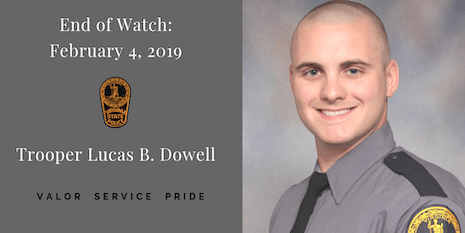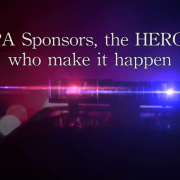Going In: The Fatal Funnel
One of the most dangerous aspects of working as a law enforcement officer is not the suspect who’s standing ready to fight, the armed robber who’s decided to stop running and turns square-off with the cop who’s been in pursuit for several blocks, or even heading to a shots-fired call. Instead, the most perilous, threatening, hazardous (you pick the synonym) situation officers face is the unknown—what they can’t see. It’s the what or who is waiting for them behind a doorway, a dark alley, or somewhere within a stairwell that sends the scary-meter off the charts.
The Fatal Funnel
The entrance to these areas of “the unknown” is often called the “fatal funnel.” For example, a murder suspect was seen entering a backyard garage at the end of dead-end street. The garage is a large building and the owner tells officers that it’s packed full of antique furniture, lots of boxes of all sizes, four old cars, a tractor, lawn care equipment, and an assortment of cabinets, shelving, and other typical garage bits and bobs.
There’s only one way in and that’s a side door made of solid metal. There are a few windows, of course, but unfortunately they’re blocked by stacks of cardboard boxes.
The door, then, is the point that separates the officers from access to the concealed killer. It’s the sole point of access to the interior of the garage. It is where the wide expanse of the outdoors narrows to a single point. The doorway and immediate area leading to it is the fatal funnel.
Unfortunately, for the officers, that doorway must be breached, and they must go inside to bring out the criminal. It’s their job. It’s their duty.
The Two “Cs”
“Cover” and “Concealment” are terms drilled into the minds of rookie officers during their academy training. They’re also stressed during briefings and training sessions for SWAT and High-Risk entry teams. All officers should keep those words and their meanings at the top of the “things I must do” each and every day” list.
A cover is an object or barrier that has the capability of likely and hopefully stopping projectiles such as bullets, rocks, bottles, etc.
Concealment is something that prevents officers from being seen. It’s any place where an officer could hide to prevent a suspect from knowing their precise position, and what he/she may be doing (reloading, calling for backup, moving into a more tactically advantageous position, etc.).
Doorways are the danger end of the fatal funnel. It’s the point where an officer can be easily seen. It’s where they’re the most vulnerable to attack, and it’s the place where it’s difficult to move out of the path of incoming projectiles. This is the place where an officer is most likely to die during a high-risk entry.

Author Lee Goldberg learns safe building entry procedures while at the 2016 Writers’ Police Academy
It’s why officers are taught to never stand in front of a doorway during a high-risk incident. After all, the advantage in these situations is definitely in the hands of the suspect. They know where the officers are positioned but it’s up to the officers to learn the bad guy’s location.
Prior to entering the home/room, the first officer to enter should take a quick peek inside using just a small portion of the head to penetrate the doorway. With firearm at ready, the shooting hand also penetrates the doorway simultaneously with the head. This action enables the officer to address an active and immediate threat. The officer should then have an idea of the layout of the room that’s immediately beyond the doorway. They may also learn the location of the suspect and other possible threats, such as animals, boobytraps, etc.

Two officers preparing to enter the fatal funnel – 2016 Writers’ Police Academy
After the quick peek it’s time to pass through the fatal funnel. It’s the decision of the first officer whether he/she goes right or left. The second officer entering must go in the opposite direction. If the first officer goes right, the second officer enters to the left. Each officer then clears the corner nearest to them.
Room clearing instruction at the 2016 Writers’ Police Academy
The eyes should be in the direction of the muzzle of the gun. Where it goes the eyes should follow. Peripheral vision is a MUST to detect movement and activity in all directions. Again, though, the immediate focus of the eyes is where the weapon is pointed.
Each area of each room must be searched in the same slow and methodical process, and each doorway within a house is its own fatal funnel.
Two techniques used to safely enter a building or room are “Criss-Crossing” and “Buttonhook.”
It is the goal of the officers to safely locate and apprehend the suspect. However, that’s not always the outcome, such as the recent shootout in Houston, where five narcotics officers serving a search warrant immediately came under fire the moment they entered the fatal funnel of the home to be searched. After the first officer entered and was shot, it was up to the remaining officers to first go in to bring out the injured officer, and then to apprehend the shooter(s). As a result, four of the officers were shot (two in the face) and a fifth suffered a knee injury.
When the first officer entered the house, he was attacked by a large pit bull. Then one of the suspects, 59-year-old Dennis Tuttle, opened fire, striking the officer in the shoulder. The officer fell and the second suspect, 58-year-old Rhogena Nicholas, tried to grab the officer’s service weapon. She was shot and killed by the officers who were on the way in to rescue their fellow officer. Tuttle was also killed during the shootout.
The officers obtained the search warrant because they knew black tar heroin was being sold from the house.
I’ve been the first officer through the fatal funnel, many times, and I can assure you that the feeling associated with doing so is practically indescribable. The adrenaline released when the decision to “go in” cannot be compared to any other. It’s a combination of fear and courage that, when teamed together, instantly forces your feet to move forward without hesitation. Your heart pounds and your vision and hearing become razor sharp. Your muscles are hard but fluid, and your mind is focused on nothing but the task at hand.
Once, when entering a house, I was attacked from the rear by man holding a steak knife in his hand. He’d been concealed behind a large piece of furniture to my right (I’d chosen to left after a quick peek). The second officer entering the room quickly stopped the attack and the third officer took the second man’s place and continued going to the right while the attacker was pulled from the room. We located the main suspect hiding in a room at the back of the house. After clearing all the rooms and cuffing everyone inside, we located a fairly substantial supply of crack cocaine.
Looking back, I think about all the times I could’ve been shot, like the officers in Houston. Would I do it again, if in that position? Absolutely.
It’s what cops do. It’s part of the job.
Fatal funnel and all.
Sadly, on the same day I posted this article about the extreme danger associated with the fatal funnel, the Virginia State Police announced this sad news. I trained at the same academy as did this brave young trooper.

Trooper Lucas B. Dowell was a member of the Virginia State Police Tactical Team that was assisting the Piedmont Regional Drug and Gang Task Force with executing a search warrant at a residence in the 1500 block of Cumberland Road/Route 45, just north of the town limits of Farmville. The Tactical Team had made entry into the residence shortly before 10 p.m. Monday when an adult male inside the residence began shooting at them. The Tactical Team members returned fire, fatally wounding the male suspect.
Trooper Dowell was transported to Southside Community Hospital in Farmville where he succumbed to his injuries.













Informative and the real thing. Thanks for sharing.
Lee I love your posts informative and fascinating. So, sorry to read about the trooper who lost his life.